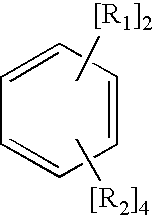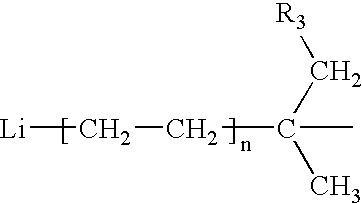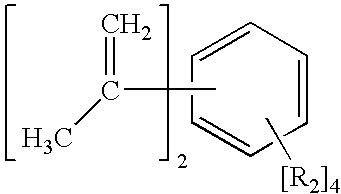Anionic polymerization diinitiator and process for preparing same
a technology of anionic polymerization and diinitiators, which is applied in the field of anionic polymerization diinitiators and a process for preparing same, can solve the problems of prone to suffer from the chemistry involved in the reaction of diisopropenylbenzene and lithium alkyl, rendering the polymer unreactive toward additional monomers, and the use of such diinitiators can also be troublesom
- Summary
- Abstract
- Description
- Claims
- Application Information
AI Technical Summary
Benefits of technology
Problems solved by technology
Method used
Image
Examples
example 1
[0031] An anionic polymerization diinitiator having primary (1°) anionic centers was prepared by charging, under nitrogen, 8.17 grams (g) (0.05 mol) 1,3-diisopropenylbenzene (1,3-DIPB), 22 g (0.79 mol) ethylene, 200 g diethyl ether, and 1700 g cyclohexane into a 1 gallon (3.78 L) autoclave and bringing the admixture to 30° C. Over a period of 210 minutes, 57.5 g of an 11.9% wt solution of sec-butyllithium (s-BuLi) (0.10 mol) was added to the autoclave. The temperature of the reaction was controlled at less than 30° C. The initially formed red color of the reaction mixture changed to a light yellow hue with time. This was an indication that the initially formed 3° benzylic anions (from the addition of s-BuLi to the C═C centers in the 1,3-DIPB) which gave a deep red colored solution was reacting with ethylene to form the desired 10 anionic centers which afforded a light yellow colored solution. To confirm this observation, an aliquot of the lithium alkyl solution was terminated by the...
example 2
[0032] The procedure of Example 1 was repeated with essentially the same results. When the preparation of the new diinitiator was complete, 200 g of butadiene was added to the reactor and polymerization ensued. The polymerization temperature was controlled below 50° C. When polymerization was complete, an aliquot of the living anionic polymer was removed from the reactor and terminated by the addition of MeOH. Analysis of the product polymer using a proton nuclear magnetic resonance, H-NMR, technique found polybutadiene having a number average molecular weight (MN) of 4,200 (MN(theory)=4,000) which was in good agreement with the theoretical value based upon the amount of initiator and monomer that were used in the experiment. Over 41% of the polymer had been formed by 1,2-addition of the butadiene to the growing anionic polymer chain. Further analysis of this sample using a gel permeation chromatography, GPC, technique, found a monomodal molecular weight distribution of polybutadien...
example 3
[0034] The product of Example 1, an anionic polymerization diinitiator having primary (1°) carbon anion centers, was prepared using a different order of addition of the reactive reagents. In this experiment, 372 g of an 8.6% wt solution of s-BuLi (0.5mol) was placed in the reactor under nitrogen. About 20 g (0.71 mol) ethylene was added to the reaction vessel. Over a period of 40 minutes, a solution of 39.6 g (0.25 mol) 1,3-DIPB in a solvent composed of 290 g cyclohexane and 78 g diethyl ether was added to the reactor. The temperature of the reaction mixture was controlled at less than 30° C. Reaction was allowed to proceed for 1 hr. An aliquot of the reaction product was analyzed for active C—Li species using a titration method that employed diphenylacetic acid as the titrant (Kofron, W. G., and Baclawski, Leona; A Convenient Method for Estimation of Alkyllithium Concentrations, Journal of Organic Chemistry, 41(10), 1879-80.); this analysis found the C—Li concentration to be 0.49 m...
PUM
| Property | Measurement | Unit |
|---|---|---|
| mole ratio | aaaaa | aaaaa |
| temperature | aaaaa | aaaaa |
| temperature | aaaaa | aaaaa |
Abstract
Description
Claims
Application Information
 Login to View More
Login to View More - R&D
- Intellectual Property
- Life Sciences
- Materials
- Tech Scout
- Unparalleled Data Quality
- Higher Quality Content
- 60% Fewer Hallucinations
Browse by: Latest US Patents, China's latest patents, Technical Efficacy Thesaurus, Application Domain, Technology Topic, Popular Technical Reports.
© 2025 PatSnap. All rights reserved.Legal|Privacy policy|Modern Slavery Act Transparency Statement|Sitemap|About US| Contact US: help@patsnap.com



